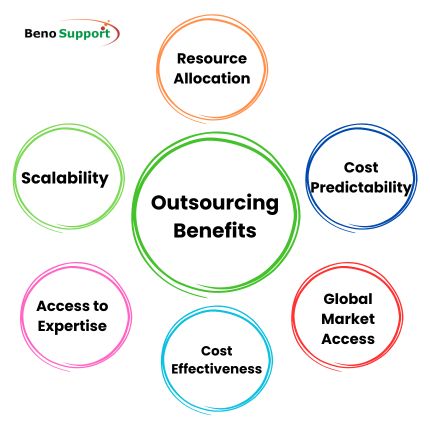There are various ways that outsourcing can promote long-term growth for a business or industry:
Cost effectiveness: By outsourcing some non-essential tasks, businesses may concentrate on their key capabilities and cut costs. Businesses can cut operating expenses and better allocate resources by assigning tasks to specialized service providers.
Access to Expertise: Outsourcing gives you access to specialized knowledge and abilities that may not be present internally. This may result in inventions and outputs of a higher caliber, which will ultimately increase a company's competitiveness and growth potential.
Scalability: With outsourcing, businesses may scale up or down fast in response to demand without making significant expenditures in infrastructure or human resources. This adaptability helps to manage operational risks while promoting effective growth.
Focus on Core Activities: By contracting out routine or non-core work, businesses may devote more time and money to their core operations, which are essential for fostering growth and creating value. Outsourcing services focus on Core activities.
Collaboration with outside vendors can help an organization innovate and be more creative by bringing in new viewpoints and ideas. New products, services, and business models may result from this.
Global Market Access: By utilizing local know-how and expertise, outsourcing can assist businesses in breaking into new markets. Increased sales, revenue, and long-term growth may result from this access to new markets.
Time to Market Slashed: Outsourcing can shorten product development and go-to-market cycles, enabling businesses to seize market opportunities faster and gain a competitive edge.
Risk management: By communicating specific operational risks to outsourcing partners, businesses can more successfully navigate uncertainty. This risk-sharing strategy can support steady growth by reducing the likelihood of setbacks.
Cost Predictability: Many outsourcing contracts have fixed or predictable costs, which help businesses better manage their budgets and plan their finances for long-term success.
Resource Allocation: Outsourcing frees up internal resources that can be applied to growth-oriented projects including strategic initiatives, research, and development.
Access to Advanced technology: Outsourcing partners frequently have access to cutting-edge infrastructure and technology, enabling businesses to take advantage of these resources without making significant upfront investments.
Efficiency Improvement: External service providers frequently bring best practices and process optimizations to the table, improving overall performance and operational efficiency.
Retail Management Services: It’s the service which helps the customers to choose the desired merchandise from the online retail stores for their personal use. It gives an overview of the concept of visual merchandising and lays emphasis on customer relationship management, brand management and sales management.
Focus on the Employees: When ordinary activities are outsourced, employees can concentrate on more important and difficult roles, which can improve morale, job satisfaction, and overall productivity.
Sustainable Business Practices: By enabling organizations to work with partners who share their environmental and social values, outsourcing can help them achieve their sustainability objectives. For instance, working with eco-friendly suppliers can improve a business's reputation for sustainability.
Learning and Adaptation: Working with outside partners exposes a business to various working methods. A culture of learning and adaptation, which is essential for long-term progress, can be fostered in this way.
In conclusion, outsourcing can support long-term growth by improving creativity, streamlining processes, lowering costs, and granting access to specialized resources and talents. However, to ensure that the selected partners are in line with the company's long-term goals, successful outsourcing necessitates careful planning, excellent communication, and a strategic approach.






Comments